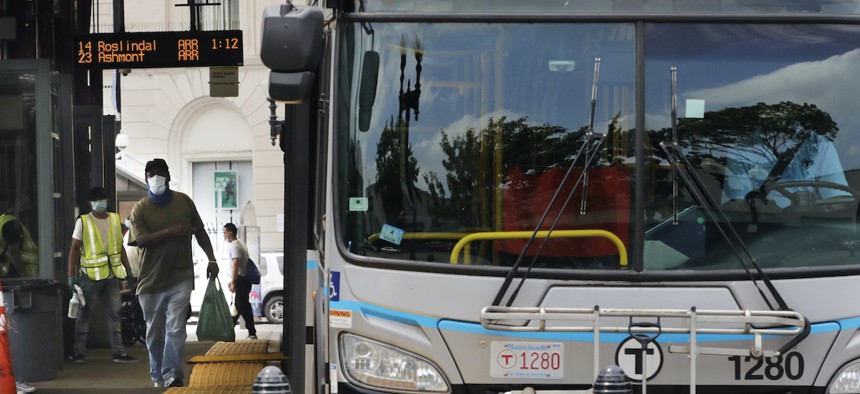Transit Authority Looks to Bus Lanes to Reduce Crowding, Encourage Social Distancing

A man, wearing a protective face mask, rushes to catch his bus at Dudley Station in Boston on June 24. Associated Press

Connecting state and local government leaders
The Massachusetts Bay Transportation Authority will add up to 14 miles of dedicated bus lanes in Boston and its suburbs to improve bus service, aiming to provide customers with room to spread out and spend less time onboard.
Transit officials in Massachusetts will create up to 14 miles of dedicated bus lanes in Boston and three of its suburbs, a regional effort designed to improve bus service, making it easier for riders to maintain social distancing as the area begins to recover from the Covid-19 pandemic.
“Throughout this pandemic, the majority of our ridership has been on our bus system,” Steve Poftak, general manager of the Massachusetts Bay Transportation Authority, said in a statement. “Advancing this program is the fastest way we can provide thousands of our riders with significant improvements in service reliability.”
The project, announced last week, will add bus lanes in Boston and the cities of Chelsea, Everett and Somerville “throughout this fall and spring,” the agency said in a statement.
Officials worked with municipalities to target bus routes that have reported the highest rates of ridership since the pandemic hit in March, along with those that experience “above-average chronic delay.”
Those routes provide transportation for essential workers, officials said. Dedicated lanes for public transportation can improve service by allowing buses to move more quickly through congested areas, limiting waiting times and crowding at bus stops, as well as on the buses themselves.
“This crisis has reminded us of the deep disparities across our region. Our most vulnerable residents have borne the brunt of this illness, even as many of them have been among our essential workforce that has never ceased heading into work every day,” Joseph A. Curtatone, mayor of Somerville, said in a statement. “Streamlined bus routes are safer bus routes, and they serve parts of our community that deserve priority attention.”
Bus lanes will be marked with striping, red paint, signage and changes in signaling, with more permanent infrastructure changes to come next year. Emergency response vehicles and school buses will also have access to the lanes, and several cities in the area will also incorporate bike lanes and pedestrian safety improvements, according to the agency.
The project is expected to cost around $20 million, most of it funded by the transportation authority. The municipalities are expected to provide additional funding for parts of the project not directly related to transport, including streetscape improvements, the agency said.
The initiative is part of the “Better Bus Project,” a five-year, $8 billion capital investment program designed to improve bus service as a whole throughout the area.
Kate Elizabeth Queram is a staff correspondent at Route Fifty and is based in Washington, D.C.

NEXT STORY: Electric Grid Investment on Track to Fall $208 Billion Short Over Next Decade, Civil Engineers Say




